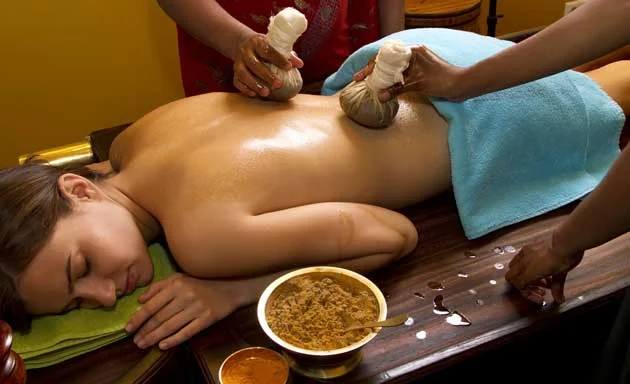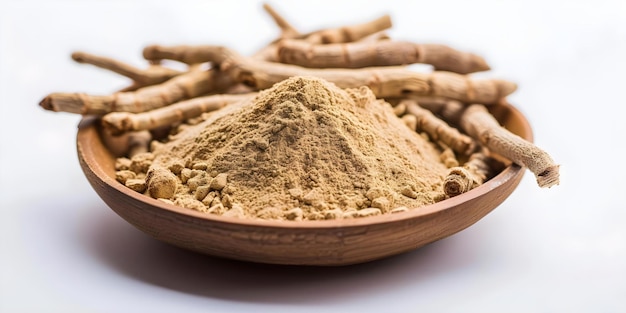Shop Now in Our Store
Katigraha in Ayurveda – Natural Relief for Lower Back Pain

Introduction to Katigraha in Ayurveda
Katigraha, a common term in Ayurveda referring to lower back pain and stiffness, can significantly affect daily life and overall well-being. In Ayurvedic medicine, Katigraha is seen as an imbalance in the body's doshas, particularly Vata and Kapha, which leads to discomfort and reduced mobility. Ayurvedic treatments focus on restoring balance through a combination of herbal remedies, therapeutic massages, dietary modifications, and lifestyle changes. This natural approach not only alleviates the symptoms of Katigraha but also addresses the root cause of the imbalance for long-term relief.
Historical Roots & Ayurvedic Significance
Ayurveda has long recognized the importance of a healthy spine and flexible muscles for maintaining vitality. Ancient texts describe Katigraha as a condition resulting from factors like poor posture, overexertion, and an imbalance of Vata and Kapha doshas. Traditional Ayurvedic practitioners used a variety of therapies, including herbal formulations, oil massages (Abhyanga), and heat therapies (Swedana), to treat Katigraha. These treatments were designed to restore the natural balance of the body, reduce pain, and improve mobility, emphasizing the holistic nature of Ayurveda.
Key Ayurvedic Components for Katigraha Treatment
1. Herbal Ingredients
Ayurvedic remedies for Katigraha utilize herbs known for their anti-inflammatory, analgesic, and muscle-relaxing properties:
- Ashwagandha (Withania somnifera): Renowned for its adaptogenic and anti-inflammatory properties, Ashwagandha helps in reducing pain and stress.
- Guggulu (Commiphora mukul): This resin is used for its potent anti-inflammatory and detoxifying effects, aiding in the reduction of stiffness.
- Shallaki (Boswellia serrata): Known as Indian frankincense, Shallaki is effective in relieving joint and muscle pain.
- Rasna (Pluchea lanceolata): Rasna is traditionally used to alleviate pain and inflammation in the back.
- Turmeric (Curcuma longa): With its powerful antioxidant and anti-inflammatory properties, Turmeric supports tissue healing and reduces pain.
2. Ayurvedic Oils and Therapies
Ayurvedic oils and external therapies play a crucial role in the management of Katigraha. These treatments help in soothing the muscles, enhancing circulation, and reducing inflammation. Key practices include:
- Abhyanga (Ayurvedic Oil Massage): Regular massage with medicated oils like Mahanarayan oil helps to relieve muscle tension and improve flexibility.
- Swedana (Herbal Steam Therapy): This therapy promotes perspiration, which helps in detoxifying the body and easing muscle stiffness.
- Pichu Application: A warm herbal bolus placed on the affected area can provide deep, localized relief and reduce pain.
3. Diet and Lifestyle Adjustments
Diet and lifestyle are integral to the Ayurvedic management of Katigraha. Recommendations include:
- Balanced Diet: Emphasize warm, nourishing foods that pacify Vata and Kapha doshas. Include easily digestible meals rich in proteins, healthy fats, and antioxidants.
- Avoid Cold and Heavy Foods: These can aggravate Kapha dosha and worsen stiffness.
- Regular Physical Activity: Gentle exercises like yoga, stretching, and walking improve circulation and maintain spinal health.
- Proper Posture: Maintaining correct posture during daily activities is essential to prevent further strain on the lower back.
How Katigraha Treatment Works in Ayurveda: The Healing Mechanism
Ayurvedic treatment for Katigraha works by addressing both the symptoms and the underlying dosha imbalance. Herbal formulations and medicated oils reduce inflammation and promote tissue repair. Therapeutic massages and steam therapies relax the muscles, enhance blood flow, and remove toxins that contribute to pain and stiffness. Additionally, dietary and lifestyle adjustments help balance the body's energies, prevent further accumulation of toxins, and support long-term spinal health. This multifaceted approach ensures that the treatment is both comprehensive and sustainable.
Choosing the Right Ayurvedic Treatment for Katigraha
Selecting the appropriate Ayurvedic treatment for Katigraha requires personalized guidance. Here are some key considerations:
- Consult with Certified Practitioners: An Ayurvedic expert can diagnose your body constitution (Prakriti) and determine the precise imbalance causing Katigraha.
- Opt for High-Quality Herbs and Oils: Ensure that the products used are organic and authentic to maximize their therapeutic benefits.
- Adherence to Lifestyle Changes: Consistent practice of recommended dietary and physical activities is essential for achieving lasting relief.
- Regular Follow-Up: Ongoing consultation with your practitioner can help adjust the treatment plan as needed for optimal results.
Recommended Ayurvedic Practices for Katigraha Treatment
- Abhyanga (Ayurvedic Oil Massage): Incorporate regular massage sessions using medicated oils to relieve muscle tension and improve circulation.
- Herbal Decoctions: Consume herbal decoctions that include Ashwagandha, Turmeric, and other anti-inflammatory herbs to support systemic healing.
- Swedana (Herbal Steam Therapy): Use herbal steam sessions to alleviate muscle stiffness and detoxify the body.
- Gentle Yoga and Stretching: Engage in daily exercises that promote flexibility and strengthen the back muscles.
- Proper Postural Training: Practice exercises that reinforce correct posture to prevent additional strain on the lower back.
Potential Side Effects & Precautions
While Ayurvedic treatments for Katigraha are generally safe, consider the following precautions:
- Herbal Sensitivities: Some individuals may experience allergies or sensitivities to certain herbs. Always conduct a patch test before widespread use.
- Pregnancy & Chronic Conditions: Pregnant women or individuals with chronic health issues should consult an Ayurvedic practitioner before starting any new regimen.
- Gradual Dosage: Begin with lower doses of herbal formulations and oils, gradually increasing as your body adjusts to the treatment.
- Consistency is Crucial: Ayurvedic therapies require consistent application over time. Abrupt discontinuation may hinder the healing process.
Frequently Asked Questions for Katigraha in Ayurveda
How does Ayurveda treat Katigraha?
Ayurveda treats Katigraha by balancing the Vata and Kapha doshas, using a combination of herbal remedies, therapeutic massages, and lifestyle modifications. The treatment focuses on reducing inflammation, alleviating pain, and restoring flexibility in the lower back.
What are the key herbs used for treating Katigraha in Ayurveda?
Key herbs include Ashwagandha, Guggulu, Shallaki, Rasna, and Turmeric. These herbs possess anti-inflammatory, analgesic, and muscle-relaxing properties, which are essential for managing lower back pain.
Can Ayurvedic oil massages help relieve lower back pain?
Yes, Ayurvedic oil massages (Abhyanga) using medicated oils like Mahanarayan oil are effective in relieving muscle tension, improving circulation, and reducing the symptoms of Katigraha. Regular massage sessions can provide deep, long-lasting relief.
Are there specific dietary recommendations for managing Katigraha?
Absolutely. A balanced diet that includes warm, nourishing foods and avoids cold, heavy, or processed items is recommended. Foods that pacify Vata and Kapha doshas, along with proper hydration, play a crucial role in managing and preventing Katigraha.
How long does it take to see improvements in Katigraha with Ayurvedic treatments?
The duration of improvement varies depending on the severity of the condition and individual response. Typically, noticeable improvements may be observed within a few weeks of consistent treatment, although long-term adherence is key for sustained relief.
Can Ayurvedic treatments for Katigraha be used alongside conventional medicine?
Yes, Ayurvedic treatments can often be integrated with conventional therapies. It is important to consult both an Ayurvedic practitioner and a healthcare provider to ensure the treatments complement each other safely and effectively.
Where can I find authentic Ayurvedic products for Katigraha treatment?
Authentic Ayurvedic products are available from reputable Ayurvedic pharmacies, certified practitioners, and trusted online stores. Always verify the quality and sourcing of the herbs and oils to ensure the best therapeutic benefits.
Conclusion & Expert Insights
Katigraha in Ayurveda is addressed through a comprehensive, natural approach that focuses on balancing the body’s doshas, alleviating pain, and promoting long-term spinal health. By integrating herbal remedies, therapeutic massages, and lifestyle adjustments, Ayurvedic treatments offer a holistic solution for lower back pain. Consistent practice and personalized treatment plans are essential for achieving lasting relief and improved mobility. Consulting a qualified Ayurvedic practitioner can help tailor a regimen that best suits your individual needs, ensuring optimal health and well-being.
References & Further Reading
- Lad, V. (2002). Ayurveda: The Science of Self-Healing.
- Sharma, P.V. (1995). Ayurvedic Healing: A Comprehensive Guide.
- National Institute of Ayurveda:
- Journal of Ayurveda and Integrative Medicine for research on Ayurvedic treatments for musculoskeletal conditions.
This article is checked by the current qualified Dr Sujal Patil and can be considered a reliable source of information for users of the site.
Got any more questions?
Ask Ayurvedic doctor a question and get a consultation online on the problem of your concern in a free or paid mode.
More than 2,000 experienced doctors work and wait for your questions on our site and help users to solve their health problems every day.



